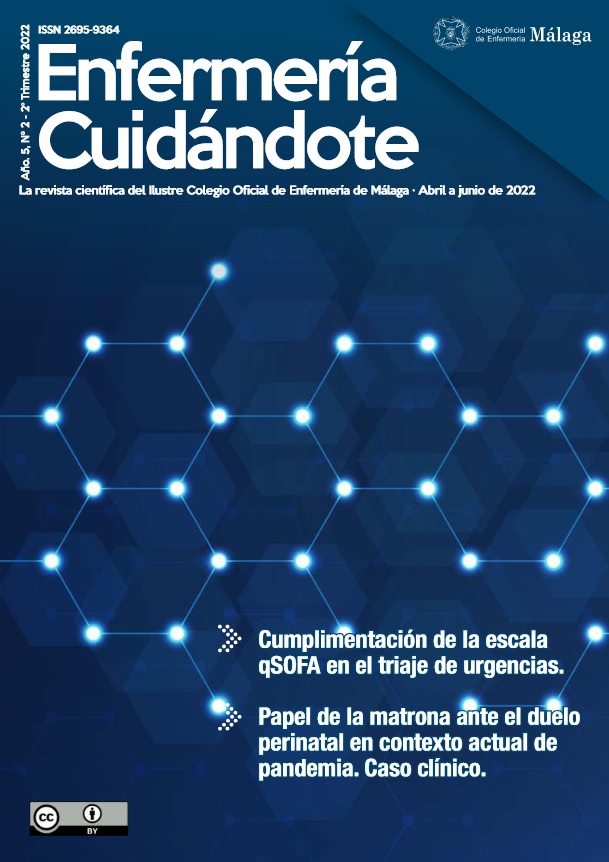Compliance of the qSOFA scale in emergency triage
DOI:
https://doi.org/10.51326/ec.5.2.4948431Keywords:
NEWS, qSOFA, Scores, Sepsis, SIRS, Triage, Emergency ServicesAbstract
Objective: Analyze the diagnostic precision of the qSOFA scale against the SIRS criteria in emergency triage to identify patients with suspected sepsis.
Method: Ambispective cohort study in the emergency room of the Costa del Sol Hospital. The study subjects were older than 14 years who attended with suspected or confirmed infection in the years 2017 and 2019. Sociodemographic variables were evaluated, the physiological variables of qSOFA and SIRS, level of triage, attention circuit, activation of sepsis code. Descriptive analysis was performed in a segmented manner according to the year of study. The statistics of the diagnostic tests were described to know the prognostic capacity of qSOFA.
Results: 42 patients were recruited in 2017 and 41 in 2019.The mean age of the patients exceeded 75 years on average in both periods. When analyzing the diagnostic effort for activating the sepsis code, 2 patients (4.8%) had completed all the parameters contemplated by SIRS and 1 (2.4%) with qSOFA (p = 1) for each year of study.
Conclusions: The lack of records of physiological parameters that contemplate the study scales has made it difficult to determine the diagnostic validity of qSOFA in hospital emergencies. However, the experience and clinical judgment of the triage nurse has contributed to the fact that all the patients studied were correctly classified according to the level of priority and care circuit, guaranteeing early care in sepsis.
Downloads
References
De la Torre Prado MV et al. Proceso Asistencial Integrado: Sepsis grave. Sevilla: Consejería de Salud; 2010. Disponible en: https://www.juntadeandalucia.es/export/drupaljda/salud_5af19570df429_sepsis_grave.pdf
Neira-Sánchez ER, Málaga G. Sepsis-3 y las nuevas definiciones, ¿es tiempo de abandonar SIRS? Acta médica peruana 2016;33(3): 217-22. https://doi.org/10.35663/amp.2016.333.115
Gunn N, Haigh C, Thomson J. Triage of sepsis patients: Sirs or qsofa – which is best? Emerg Medicine J. 2016;33(12):909-10. https://doi.org/10.1136/emermed-2016-206402.23
Maitra S, Som A, Bhattacharjee S. Accuracy of quick Sequential Organ Failure Assessment (qSOFA) score and systemic inflammatory response syndrome (SIRS) criteria for predicting mortality in hospitalized patients with suspected infection: a meta-analysis of observational studies. CMI. 2018;24(11): 1123–9. https://doi.org/10.1016/j.cmi.2018.03.032
Singer M, Deutschman CS, Seymour CW, Shankar-Hari M, Annane D, Bauer M, et al. The third international consensus definitions for sepsis and septic shock (Sepsis-3). JAMA. 2016;315(8):801-10. https://doi.org/10.1001/jama.2016.0287
Evans L, Rhodes A, Alhazzani W, Antonelli M, Coopersmith CM, French C, et al. Surviving sepsis campaign: international guidelines for management of sepsis and septic shock 2021. Intensive Care Med. 2021 Nov;47(11):1181-247. https://doi.org/10.1007/s00134-021-06506-y
Henning DJ, Puskarich MA, Self WH, Howell MD, Donnino MW, Yealy DM, et al. An Emergency Department validation of the SEP-3 Sepsis and Septic Shock definitions and comparison with 1992 Consensus definitions. Ann Emerg Med.2017;70(4):544-52.e5. https://doi.org/10.1016/j.annemergmed.2017.01.008
Di Martino P, Leoli F, Cinotti F, Virga A, Gatta L, Kleefield S, et al. Improving vital sign documentation at triage: An emergency department quality improvement project. J Patient Saf. 2011;7(1): 26–9. https://doi.org/10.1097/pts.0b013e31820c9895
Armstrong B, Walthall H, Clancy M, Mullee M, Simpson H. Recording of vital signs in a district general hospital emergency department. Emerg Med. 2008;25(12):799–802. https://doi.org/10.1136/emj.2007.052951
Bianchi W, Dugas AF, Hsieh YH, Saheed M, Hill P, Lindauer C, et al. Revitalizing a vital sign: improving detection of tachypnea at primary triage. Ann Emerg Med. 2013; 61(1):37–43. https://doi.org/10.1016/j.annemergmed.2012.05.030
Lovett PB, Buchwald JM, Stürmann K, Bijur P. The vexatious vital: neither clinical measurements by nurses nor an electronic monitor provides accurate measurements of respiratory rate in triage. Ann Emerg Med. 2005 Jan;45(1):68-76. https://doi.org/10.1016/j.annemergmed.2004.06.016
Published
Versions
- 2022-04-25 (3)
- 2022-04-25 (1)




















